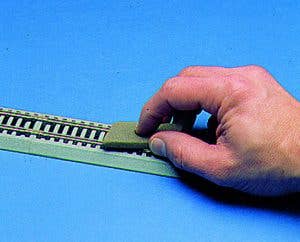Many of us, even seasoned modelers, have trains we bring out only for the holidays. After all, what’s a Christmas tree without a holiday train running ’round it? It’s a tradition that can be traced back over 150 years. But, to make sure it keeps running reliably there are a few preparation steps you may consider to keep the fun rolling under the tree or for any temporary setup!

- Carefully unpack and inspect your train for any damage
Even the most rugged model train is subject to damage in storage. Its box may get kicked, dropped, wet or crushed and the train inside can be damaged, which is common. Check the couplers to see if they’re all there. Re-position dislodged wheel sets. If present, clean off smoke fluid that may have seeped out. Make sure to remove Styrofoam bubbles, paper scraps, foam rubber crumbs and anything else that may stick to your train or track.
- Inspect and clean the track

As with the trains, track needs attention to ensure reliability. Inspect for missing joiners, broken clips on roadbed track, loose rails, bent rails and other defects and replace broken parts or sections. Clean the railheads – even though they may appear clean, they may have a thin film of corrosion or dirt (especially in high-humidity regions), and it’s easier to clean them before assembly than crawling under the tree! If you’re not sure which cleaner to use, here’s a link to a variety of cleaners for model trains.
- Clean and lube your locomotive
Take a closer look at the underside of your locomotive or trolley. Clean out visible dust, pet hair, carpet fibers, tinsel, glitter, tree skirting and lint. If you find fibers wrapped around exposed gearing or wheels and axles remove it with a toothpick, dental pick or small tweezers. Clean the wheel tread for electrical reliability. If your train has a smoke unit, make sure to inspect for fluid that has leeched out and clean it off. If you’re not sure what to use check out the cleaner link above for a few suggestions.
Sometimes, but seldom, locomotives need light lubrication.
Plastic-compatible lubricants must always be used and they should be applied sparingly only to exposed gearing as noted in the lubrication instructions of your locomotive. One drop is normally enough, too much can cause electrical problems and can attract lint and dirt.
- Inspect your power pack
Safety is the most important thing to consider. Make sure all of the wires are in good condition with no fraying or missing insulation. If you find a problem you may need to replace the power pack or wires.
- Freight and passenger cars need love too
While rolling stock simply follows along, cars have their own maintenance needs. Check for fibers and debris on the wheels and axles and remove them as you would on a locomotive. If the cars are lighted you may want to clean the wheels the same as you might clean loco wheels.
- Test run
Before you set up your entire layout hook up your power pack to a couple of pieces of track and test run your locomotive and cars back and forth to make sure everything works. Check the couplers and make sure they stay together, if not then repair or replace. If you have a smoke unit, add fluid according to the manufacturers’ instructions.
- Clear the way
Setting up track is much easier with plenty of space to work. Many folks set up the track before setting up the tree, and some set everything up on a board. For best results choose a level, or near-level surface. Make sure to leave a few inches clearance above the train and any tree branches and ornaments. Keep tinsel (especially metal tinsel which can cause electrical shorts) far, far away. Also keep Christmas village buildings and scenery at least two inches away on either side.
- Set up your track and hook up your power pack
Roadbed-style track (with a simulated ballast base) can be set up on any surface including carpet with no bad effects on your trains. If you have conventional track (you can see through the spaces between the ties and rails) consider inserting wood, cardboard or even tape that’s wider than the track to provide a fiber-free surface. Just a single carpet or tree skirt fiber, or tinsel can ruin a locomotive if it gets caught in the mechanism. Here’s a hint for reliability: if you’re using conventional track try a piece of duct tape on the underside of six or eight ties at each track joint to hold the pieces together as the track moves under the weight of the passing trains.
- Get your trains on the line
When you’re satisfied with your track layout go ahead and put your trains on the track. If you find that the tree, buildings, presents or other decorations make rerailing the trains difficult consider a rerailer track (you may have one already) or rerailing tool. Here’s an assortment of
rerailing tracks and tools. Although there are many choices you may consider a ramp-style rerailer to help with rerailing cars in the limited confines of space under the tree.
- Run like Rudolph!
Crack open the throttle and let your trains run! For safety, keep an eye out for obstructions as presents get moved around and track shifts on soft surfaces.
The tradition of having a holiday train is one that still exists because it’s fun. Keeping those trains running takes a little bit of work and when done correctly can make the holiday train even more fun. If you’re considering a holiday train for the first time or giving one as a gift,
consider starting with a train-set.
Loading...
359 view(s)








